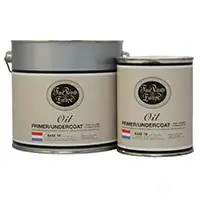Tools: Use first quality, clean natural bristle brush (we recommend the Omega Small)
Flats S57’s and Omega Round Sash brush); for exterior work or larger brush projects, we recommend the Omega Large Full Oval S55-2 or S55-3; or professional-quality roller covers in 3/8” nap.
Spray: Under normal environmental conditions, this product requires no thinning. Clean up with FPE Mineral Spirits.
New Unpainted Wood: After preparation apply one coat and allow to dry for a minimum of 24 hours before recoating.
On new construction, we highly recommend that all exterior wood be primed on all “six” sides before nailing in place. There is no need for these wooden elements to dry before nailing. By priming the ends and open grain of exterior woodwork, you will prevent moisture intrusion and protect the value of new construction. If primer is absorbed by new wood and uniform surface film is not created, repriming should take place before finish paint is applied.
NOTE: When priming high quality resinous woods such as mahogany, we recommend that wood be wiped down with clean rag and lacquer thinner immediately before priming. This will “leech” out natural surface oils and allow primer to penetrate.
NOTE: When priming new sheetrock or wallboard, use EUROLUX waterborne primer rather than FPE Oil Primer/Undercoat, as the use of an alkyd may result in ”paper lift”. For best results, lightly sand Oil Primer/ Undercoat (220 or finer) before applying HOLLANDLAC Enamel in high focus areas.
Work area should always be well ventilated.
On sound calcimine: Painting over inexpensive calcimine paint has long been problematic because of its hard to stick to, chalky surface.
Fine Paints of Europe has developed the perfect solution to this problem in our Calcimine Undercoat and Calcimine Recoater offerings, namely our Oil Primer and Matte Oil.
These two products are specifically designed to penetrate deep into the binder-less calcimine and add back the missing binder.
No sanding necessary, simply roll on one coat of Calcimine Undercoater, followed by two topcoats of Calcimine Recoater. This system’s ability to “laminate” will reinforce and stabilize calcimine’s delicate film.
Oil Primer and Matte Oil are highly effective for calcimine surfaces. These two products are offered as a calcimine primer and calcimine recoater and are specially formulated to add years of service and polish back to your walls.

